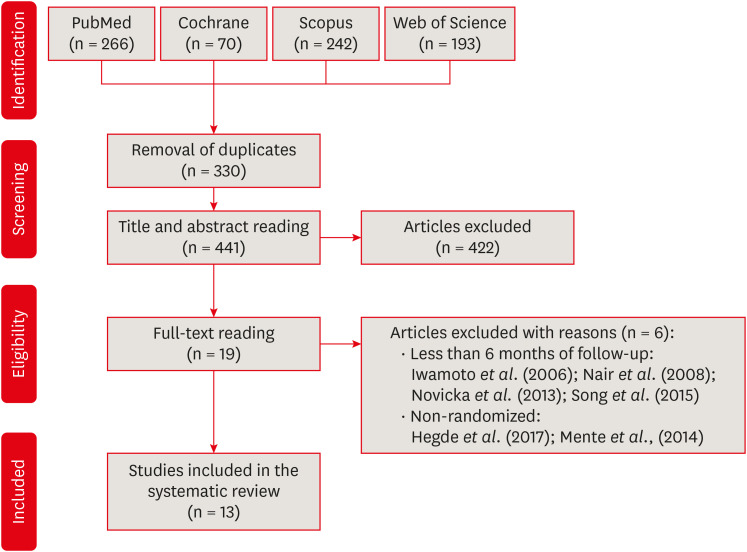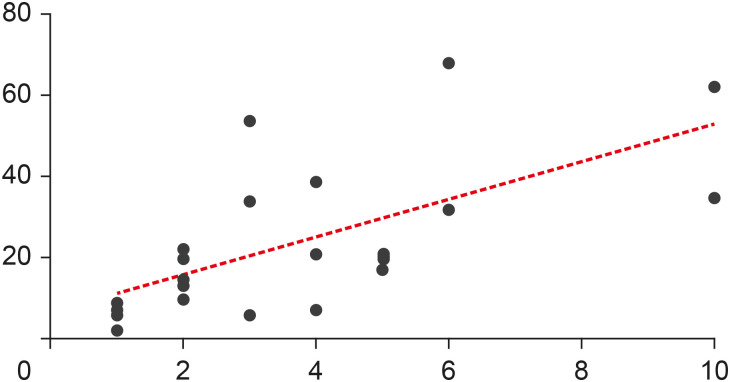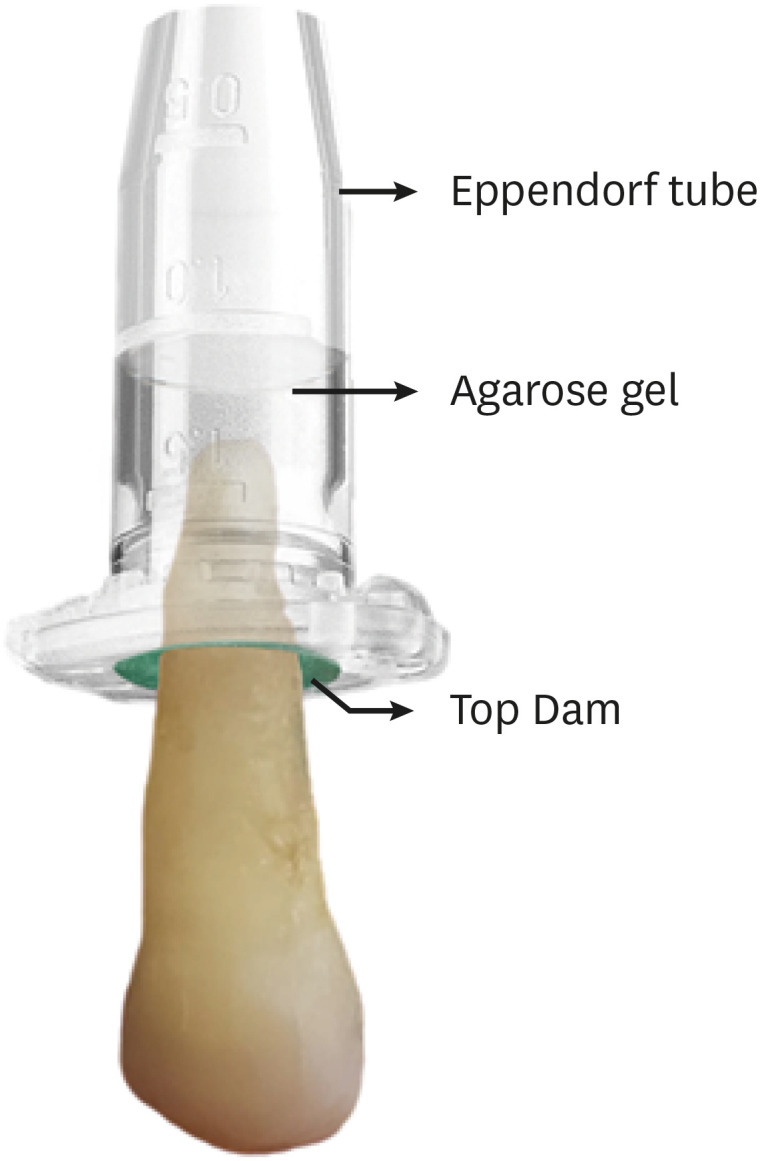Search
- Page Path
- HOME > Search
- Success rate of direct pulp capping on permanent teeth using bioactive materials: a systematic review and meta-analysis of randomized clinical trials
- Karem Paula Pinto, Gabriela Ribeiro da Silva, Cláudio Malizia Alves Ferreira, Luciana Moura Sassone, Emmanuel João Nogueira Leal da Silva
- Restor Dent Endod 2024;49(4):e34. Published online September 6, 2024
- DOI: https://doi.org/10.5395/rde.2024.49.e34

-
 Abstract
Abstract
 PDF
PDF Supplementary Material
Supplementary Material PubReader
PubReader ePub
ePub This systematic review and meta-analysis aimed to evaluate the success rate of direct pulp capping (DPC) on permanent teeth, comparing the use of MTA with calcium hydroxide and calcium silicate-based cements. A systematic search was carried out in 4 databases until July 2023. The selection was based on PICOS criteria and only randomized clinical trials were included. The risk of bias was assessed using RoB-2 tool, and meta-analyses were performed using RevMan 5.3 software. The overall quality of evidence was determined using the GRADE tool. Thirteen studies were included. Meta-analyses indicated significantly higher success rate for DPC using MTA compared to calcium hydroxide, while no significant difference was observed between MTA and Biodentine, showing a success rate from 80% to 100% even after 3 years of follow-up. Five studies were classified as having high risk of bias and the GRADE assessment revealed low certainty of evidence. DPC is highly effective for permanent teeth when using MTA or Biodentine. There is a need for future well-designed randomized clinical trials to evaluate the efficacy of DPC using newer bioceramic materials.
- 5,062 View
- 242 Download

- Ten years of minimally invasive access cavities in Endodontics: a bibliometric analysis of the 25 most-cited studies
- Emmanuel João Nogueira Leal Silva, Karem Paula Pinto, Natasha C. Ajuz, Luciana Moura Sassone
- Restor Dent Endod 2021;46(3):e42. Published online July 21, 2021
- DOI: https://doi.org/10.5395/rde.2021.46.e42

-
 Abstract
Abstract
 PDF
PDF PubReader
PubReader ePub
ePub Objectives This study aimed to analyze the main features of the 25 most-cited articles in minimally invasive access cavities.
Materials and Methods An electronic search was conducted on the Clarivate Analytics' Web of Science ‘All Databases’ to identify the most-cited articles related to this topic. Citation counts were cross-matched with data from Elsevier's Scopus and Google Scholar. Information about authors, contributing institutions and countries, year and journal of publication, study design and topic, access cavity, and keywords were analyzed.
Results The top 25 most-cited articles received a total of 572 (Web of Science), 1,160 (Google Scholar) and 631 (Scopus) citations. It was observed a positive significant association between the number of citations and age of publication (
r = 0.6907,p < 0.0001); however, there was no significant association regarding citation density and age of publication (r = −0.2631,p = 0.2038). TheJournal of Endodontics made the highest contribution (n = 15, 60%). The United States had the largest number of publications (n = 7) followed by Brazil (n = 4), with the most contributions from the University of Tennessee and Grande Rio University (n = 3), respectively. The highest number of most-cited articles wereex vivo studies (n = 16), and ‘fracture resistance’ was the major topic studied (n = 10).Conclusions This study revealed a growing interest for researchers in the field of minimally invasive access cavities. Future trends are focused on the expansion of collaborative networks and the conduction of laboratory studies on under-investigated parameters.
-
Citations
Citations to this article as recorded by- Research Trends in Internal Root Resorption from 1947 to 2022: A Bibliometric Analysis of the 50 Most-cited Articles
Laise Pena Braga Monteiro, Larissa Pillar Gomes Martel, Roberta Fonseca de Castro, Emmanuel João Nogueira Leal da Silva, Juliana Melo da Silva Brandão
Journal of Advanced Oral Research.2025;[Epub] CrossRef - Bibliometric analysis of the publications that list the most-cited articles in endodontics
Oscar Alejandro Gutiérrez-Alvarez, Luis Alberto Pantoja-Villa, Benigno Miguel Calderón-Rojas
Endodontology.2025; 37(2): 128. CrossRef - Evaluation of the forces applied by rubber dam clamps on mandibular first molar teeth with different endodontic access cavities: a 3D FEA study
Mehmet Eskibağlar, Serkan Erdem, Büşra Karaağaç Eskibağlar, Mete Onur Kaman
PeerJ.2024; 12: e17921. CrossRef - A Global Overview of Guided Endodontics: A Bibliometric Analysis
Thaine Oliveira Lima, Aurélio de Oliveira Rocha, Lucas Menezes dos Anjos, Nailson Silva Meneses Júnior, Marco Antonio Hungaro Duarte, Murilo Priori Alcalde, Mariane Cardoso, Rodrigo Ricci Vivan
Journal of Endodontics.2024; 50(1): 10. CrossRef - Novel method for augmented reality guided endodontics: An in vitro study
Marco Farronato, Andres Torres, Mariano S. Pedano, Reinhilde Jacobs
Journal of Dentistry.2023; 132: 104476. CrossRef - Contribution of Türkiye to the Field of Endodontology: A Visualized Bibliometric Analysis Based on Web of Science
Olcay ÖZDEMİR, Yağız ÖZBAY, Neslihan YILMAZ ÇIRAKOĞLU
Medical Records.2023; 5(1): 91. CrossRef - Effect of access cavities on the biomechanics of mandibular molars: a finite element analysis
Xiao Wang, Dan Wang, Yi-rong Wang, Xiao-gang Cheng, Long-xing Ni, Wei Wang, Yu Tian
BMC Oral Health.2023;[Epub] CrossRef - Contemporary research trends on nanoparticles in endodontics: a bibliometric and scientometric analysis of the top 100 most-cited articles
Sıla Nur Usta, Zeliha Uğur-Aydın, Kadriye Demirkaya, Cumhur Aydın
Restorative Dentistry & Endodontics.2023;[Epub] CrossRef - Evolving trend of systematic reviews and meta-analyses in endodontics: A bibliometric study
GalvinSim Siang Lin, JiaZheng Leong, WenXin Chong, MikoChong Kha Chee, ChinSheng Lee, Manahil Maqbool, TahirYusuf Noorani
Saudi Endodontic Journal.2022; 12(3): 236. CrossRef - Global research trends on photodynamic therapy in endodontics: A bibliometric analysis
Lucas Peixoto de Araújo, Wellington Luiz de Oliveira da Rosa, Leandro Bueno Gobbo, Tamares Andrade da Silva, José Flávio Affonso de Almeida, Caio Cezar Randi Ferraz
Photodiagnosis and Photodynamic Therapy.2022; 40: 103039. CrossRef - Minimal Invasive Endodontics: A Comprehensive Narrative Review
Jaydip Marvaniya, Kishan Agarwal, Dhaval N Mehta, Nirav Parmar, Ritwik Shyamal , Jenee Patel
Cureus.2022;[Epub] CrossRef
- Research Trends in Internal Root Resorption from 1947 to 2022: A Bibliometric Analysis of the 50 Most-cited Articles
- 754 View
- 11 Download
- 7 Web of Science
- 11 Crossref

- Shaping ability and apical debris extrusion after root canal preparation with rotary or reciprocating instruments: a micro-CT study
- Emmanuel João Nogueira Leal da Silva, Sara Gomes de Moura, Carolina Oliveira de Lima, Ana Flávia Almeida Barbosa, Waleska Florentino Misael, Mariane Floriano Lopes Santos Lacerda, Luciana Moura Sassone
- Restor Dent Endod 2021;46(2):e16. Published online February 25, 2021
- DOI: https://doi.org/10.5395/rde.2021.46.e16

-
 Abstract
Abstract
 PDF
PDF PubReader
PubReader ePub
ePub Objectives The aim of this study was to evaluate the shaping ability of the TruShape and Reciproc Blue systems and the apical extrusion of debris after root canal instrumentation. The ProTaper Universal system was used as a reference for comparison.
Materials and Methods Thirty-three mandibular premolars with a single canal were scanned using micro-computed tomography and were matched into 3 groups (
n = 11) according to the instrumentation system: TruShape, Reciproc Blue and ProTaper Universal. The teeth were accessed and mounted in an apparatus with agarose gel, which simulated apical resistance provided by the periapical tissue and enabled the collection of apically extruded debris. During root canal preparation, 2.5% sodium hypochlorite was used as an irrigant. The samples were scanned again after instrumentation. The percentage of unprepared area, removed dentin, and volume of apically extruded debris were analyzed. The data were analyzed using 1-way analysis of variance and the Tukey test for multiple comparisons at a 5% significance level.Results No significant differences in the percentage of unprepared area were observed among the systems (
p > 0.05). ProTaper Universal presented a higher percentage of dentin removal than the TruShape and Reciproc Blue systems (p < 0.05). The systems produced similar volumes of apically extruded debris (p > 0.05).Conclusions All systems caused apically extruded debris, without any significant differences among them. TruShape, Reciproc Blue, and ProTaper Universal presented similar percentages of unprepared area after root canal instrumentation; however, ProTaper Universal was associated with higher dentin removal than the other systems.
-
Citations
Citations to this article as recorded by- A quantitative comparison of apically extruded debris during root canal preparation using NiTi full-sequence rotary and single-file rotary systems: An in vitro study
Pallavi Goel, R. Vikram, R. Anithakumari, M. S. Adarsha, M. E. Sudhanva
Endodontology.2024; 36(3): 235. CrossRef - Extrusion of Sodium Hypochlorite in Oval-Shaped Canals: A Comparative Study of the Potential of Four Final Agitation Approaches Employing Agarose-Embedded Mandibular First Premolars
Aalisha Parkar, Kulvinder Singh Banga, Ajinkya M. Pawar, Alexander Maniangat Luke
Journal of Clinical Medicine.2024; 13(10): 2748. CrossRef - Shaping Efficiency of Rotary and Reciprocating Kinematics of Engine-driven Nickel-Titanium Instruments in Moderate and Severely curved Root Canals Using Microcomputed Tomography: A Systematic Review of Ex Vivo Studies
Claudiu Călin, Ana-Maria Focșăneanu, Friedrich Paulsen, Andreea C. Didilescu, Tiberiu Niță
Journal of Endodontics.2024; 50(7): 907. CrossRef - Intracanal removal and apical extrusion of filling material after retreatment using rotary or reciprocating instruments: A new approach using human cadavers
Thamyres M. Monteiro, Victor O. Cortes‐Cid, Marilia F. V. Marceliano‐Alves, Andrea F. Campello, Luan F. Bastos, Ricardo T. Lopes, José F. Siqueira, Flávio R. F. Alves
International Endodontic Journal.2024; 57(1): 100. CrossRef - Assessment of debris extrusion on using automated irrigation device with conventional needle irrigation – An ex vivo study
Sahil Choudhari, Kavalipurapu Venkata Teja, Raja Kumar, Sindhu Ramesh
Saudi Endodontic Journal.2023; 13(3): 263. CrossRef - Postoperative pain perception and associated risk factors in children after continuous rotation versus reciprocating kinematics: A randomised prospective clinical trial
Ahmad Abdel Hamid Elheeny, Dania Ibrahem Sermani, Mahmoud Ahmed Abdelmotelb
Australian Endodontic Journal.2023; 49(S1): 345. CrossRef - A critical analysis of research methods and experimental models to study apical extrusion of debris and irrigants
Jale Tanalp
International Endodontic Journal.2022; 55(S1): 153. CrossRef - Quantitative evaluation of apically extruded debris using TRUShape, TruNatomy, and WaveOne Gold in curved canals
Nehal Nabil Roshdy, Reham Hassan
BDJ Open.2022;[Epub] CrossRef - Shaping ability of new reciprocating or rotary instruments with two cross‐sectional designs: An ex vivo study
Isabela G. Guedes, Renata C. V. Rodrigues, Marília F. Marceliano‐Alves, Flávio R. F. Alves, Isabela N. Rôças, José F. Siqueira
International Endodontic Journal.2022; 55(12): 1385. CrossRef
- A quantitative comparison of apically extruded debris during root canal preparation using NiTi full-sequence rotary and single-file rotary systems: An in vitro study
- 770 View
- 25 Download
- 7 Web of Science
- 9 Crossref


 KACD
KACD

 First
First Prev
Prev


